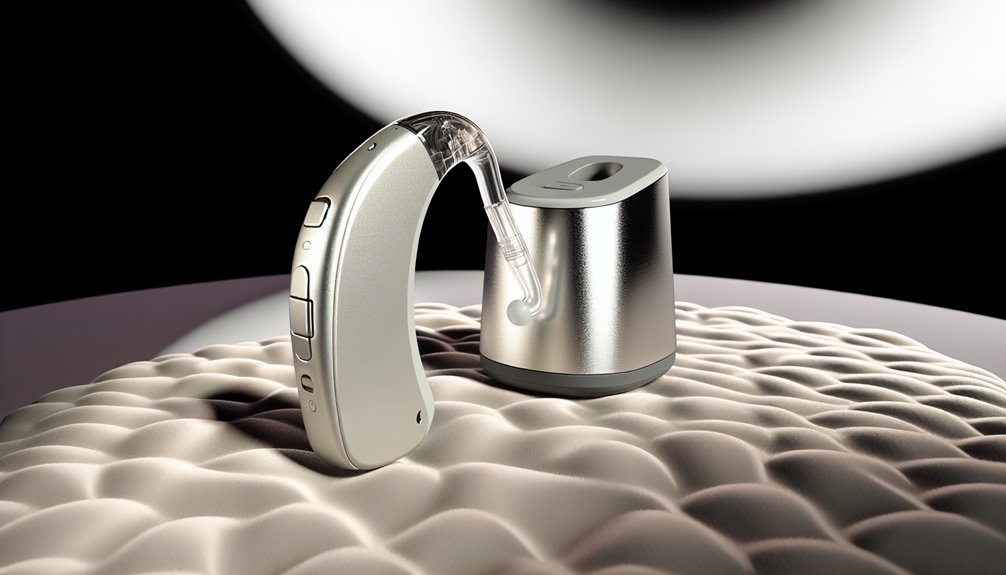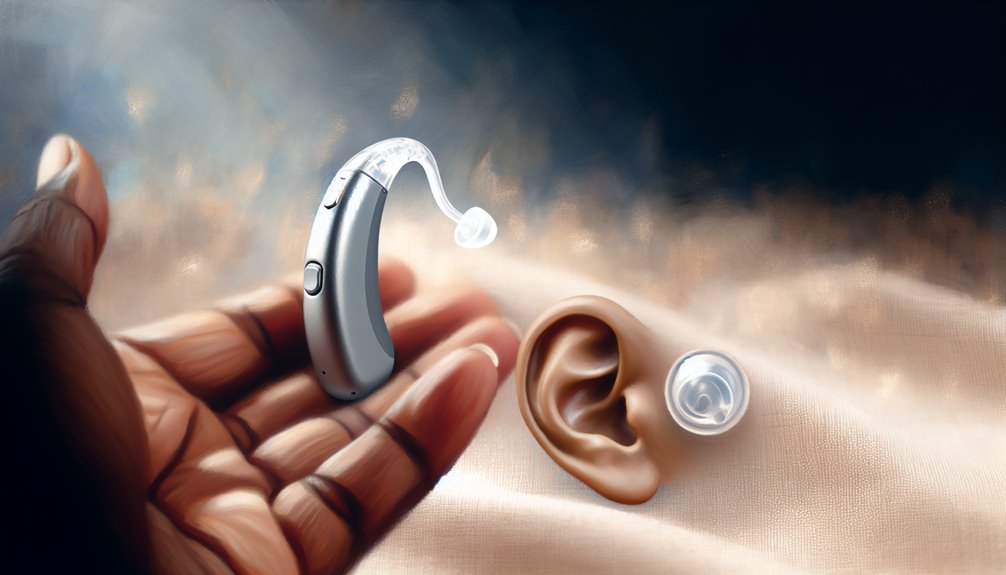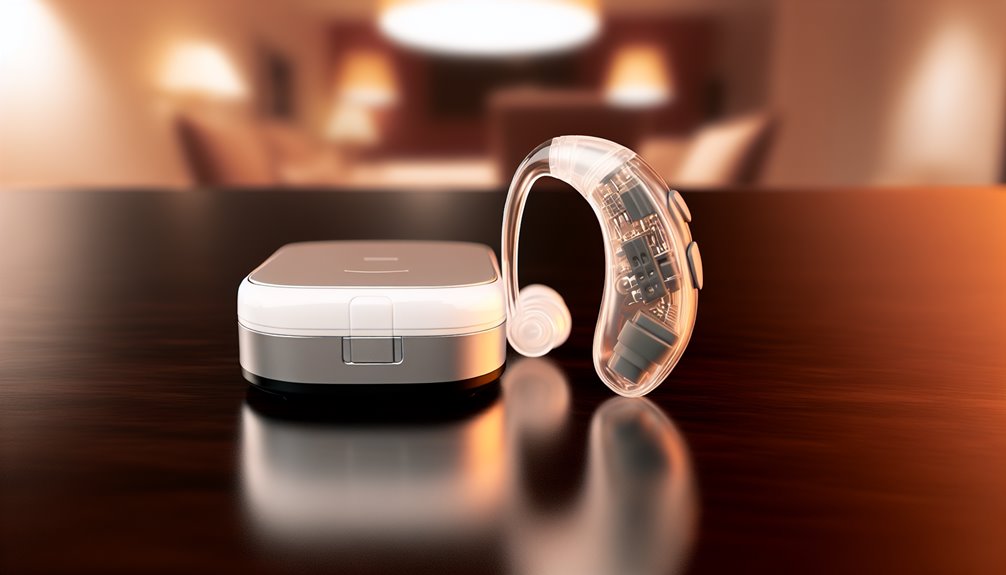This review evaluates the functionality of rechargeable behind-the-ear hearing aids, emphasizing their design, comfort, and audio performance. Featuring advanced digital signal processing, these devices enhance speech clarity while minimizing background noise. Their lightweight, ergonomic design guarantees prolonged wear without discomfort. Rechargeable batteries deliver over 24 hours of use on a single four-hour charge, supplemented with a low battery warning feature. User feedback highlights sound quality and comfort, though some concerns about ear pad sealing have emerged. Overall, these hearing aids provide significant benefits, though experiences may vary based on individual needs and environments. Further insights can expand understanding of these devices.
Key Takeaways
- The behind-the-ear design offers discreet wear and is crafted for long-term comfort using medical-grade materials.
- Advanced digital signal processing enhances sound clarity and reduces background noise, improving speech comprehension in various environments.
- A sleek charging station with magnetic connections allows for easy recharging, providing over 24 hours of continuous operation on a full charge.
- Users appreciate the lightweight design and user-friendly volume adjustment mechanism, enhancing overall satisfaction during prolonged use.
- Some customers report issues with ear pad sealing, which can impact sound delivery and overall hearing experience.
Product Features Overview

The advanced design of these rechargeable hearing aids incorporates several key features aimed at enhancing auditory experience. Particularly, the devices utilize digital signal processing technology, which markedly improves sound quality by enhancing the clarity of human voices while simultaneously reducing background noise. This feature is essential for individuals seeking hearing benefits in various environments, allowing for better communication in both quiet and noisy settings. Additionally, the hearing aids are equipped with two adaptive programs that cater to different auditory contexts, ensuring peak performance across diverse situations. The lightweight, behind-the-ear design provides long-term comfort, crafted from medical-grade materials that facilitate extended wear without discomfort. These innovations collectively contribute to a superior auditory experience for those with mild to moderate hearing loss.
Charging and Battery Performance
Efficient charging and impressive battery life are essential components of modern rechargeable hearing aids. These devices typically feature a charging station design that is both sleek and user-friendly, incorporating magnetic connections for ease of use. Battery life expectations for these hearing aids are remarkable, as a full charge—achieved in approximately four hours—can provide over 24 hours of continuous operation. This extended battery performance is particularly advantageous for users, minimizing the need for frequent recharging. Additionally, a low battery warning indicator enhances reliability, ensuring users remain informed about their device's power status. Overall, the combination of efficient charging and robust battery life enhances the practicality and functionality of rechargeable hearing aids, making them a compelling choice for individuals with hearing loss.
User Experience Insights

User experience plays a vital role in the effectiveness of hearing aids, particularly for individuals with mild to moderate hearing loss. The design of these devices profoundly impacts user satisfaction and hearing expectations. Features such as the adaptive programs and digital signal processing enhance sound clarity and reduce background noise, catering to varied listening environments. The lightweight casing and open fit design promote comfort during prolonged usage, which is essential for daily wear. Additionally, the user-friendly volume adjustment mechanism allows for easy customization of sound levels. Overall, a positive user experience is pivotal in ensuring that users can fully benefit from the hearing aids, ultimately leading to improved auditory engagement and communication in social settings.
Customer Feedback Highlights
Customer feedback on the rechargeable hearing aids reveals a spectrum of experiences that highlight both strengths and weaknesses of the product. Many users commend the sound quality, noting its clarity and effectiveness in enhancing speech comprehension, particularly in noisy environments. However, some customers express concerns regarding the device's performance, indicating that it may not consistently meet their hearing expectations, especially for more severe hearing loss. While the comfort and lightweight design are frequently praised, issues related to the ear pads not providing an adequate seal have been reported, potentially impacting sound delivery. Overall, the feedback underscores the importance of individual hearing needs and the variability in user experiences with this technology.
Final Thoughts on Performance

Often regarded as a viable option for individuals with mild to moderate hearing loss, the performance of these rechargeable hearing aids largely hinges on individual user needs and environmental factors. The sound quality is enhanced through digital signal processing, allowing for improved clarity of the human voice while minimizing background noise. Users' personal preferences substantially influence their overall satisfaction, as the effectiveness of adaptive programs in varying environments can vary. While many appreciate the lightweight design and comfort, some users reported issues with ear pad sealing, impacting sound delivery. Overall, these hearing aids provide a balanced performance, meeting the requirements for many, although individual experiences can differ widely based on specific auditory needs.
Frequently Asked Questions
How Do I Clean and Maintain My Hearing Aids?
To guarantee peak performance of hearing aids, establish daily routines and cleaning schedules. Begin by gently wiping the device with a soft, dry cloth to remove moisture and debris. Regularly inspect and clean the ear tips using warm soapy water, verifying they are thoroughly dried before reattachment. Additionally, utilize a specialized hearing aid dryer or dehumidifier weekly to prevent moisture accumulation. Adhering to these practices will enhance longevity and functionality of the devices.
Can I Use Hearing Aids With My Smartphone?
Approximately 70% of modern hearing aids are designed to be compatible with smartphones, allowing users to manage audio settings directly from their devices. This integration enhances sound quality by enabling personalized adjustments, streamlining the listening experience in various environments. Users can connect their hearing aids via Bluetooth, facilitating seamless control over volume, program selection, and sound enhancement features. Consequently, this connectivity substantially improves user satisfaction and overall hearing aid functionality.
Are There Any Warranty Options Available for These Devices?
Warranty options for hearing devices typically include a manufacturer guarantee, which covers defects in materials and workmanship for a specified period. Additionally, extended protection plans may be available, offering coverage beyond the standard warranty. These plans often encompass accidental damage and wear-and-tear issues, guaranteeing enhanced longevity and performance of the devices. It is advisable to review the specific terms of coverage and conditions provided by the manufacturer to secure thorough protection.
How Long Does the Battery Last on a Full Charge?
Remarkably, a single charge of these advanced hearing aids provides over 24 hours of daily usage, aligning seamlessly with typical consumer needs. This impressive battery life is achieved through efficient power consumption, allowing users to engage in various activities without frequent recharging interruptions. The rechargeable design guarantees both convenience and reliability, making these devices particularly suitable for individuals experiencing mild to moderate hearing loss, while enhancing their auditory experience throughout the day.
Are These Hearing Aids Suitable for Children?
The suitability of these hearing aids for children largely depends on their specific design and features. While they possess advanced technology beneficial for mild to moderate hearing loss, they may lack kid-friendly features essential for pediatric use. Consulting a pediatric audiologist is advisable to determine if these devices meet a child's unique auditory needs. A thorough assessment guarantees that any chosen hearing aid facilitates prime hearing development and comfort in younger users.
